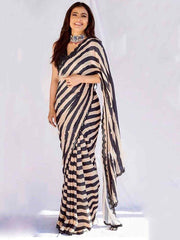
STRIPS - THE NEW TREND
Posted on December 15 2022
The new normal is the strips. It’s the season of recycling fashion. From masses to seasoned stylists, everyone seems to be head over heels with a lot of old-school basics, and this time stripes ace the list. The conspicuous detail has flooded the Indian market as strongly as in the global scenario. Zebra stripes are one of the coolest prints of the year! That may just lead you on to wearing a black and white striped saree for the next party. The trend is not about only monochromatic bands; stripes look appealing in every possible color combination. They are also socially acceptable as formal as well as informal wear. You can impress your office crowd with a striped cotton trouser suit and lead your style squad with a designer striped tunic. In today’s era ,we treat sarees as occasional wear or a garment to be worn mostly on special days.
But were sarees always part of a fashion statement, party wear or just occasional clothing?
How did the saree get its name?
The word sari evolved from a popular Sanskrit word "Sati" which means strip of cloth and "static" which means women's attire. "Sattika" was ideally a 3 piece ensemble which was worn by women, and today those 3 pieces of cloth took the shape of dupatta, choli, and skirt .In the vintage era, women used to wear regional handloom sarees made of silks, cotton, etc. Most prominent silk sarees being Banarasi, Uppada, Chanderi, etc. which were traditionally worn for special days like festivals or marriages. Where as cotton sarees like Patola, Pochampalli, Sambalpuri, Jamdani, Tant, etc. were mostly worn as everyday clothing. Even the yarns were dyed using natural colors which were mostly extracted from plants like Indigo, turmeric and different flowers .Indian saree is one that has been maintained, toiled, modified, and continues to emerge in different forms using different fabrics, different stylings, different drapes, different dyes but remains consistent in providing grace, power, and comfort to the wearer. A garment like the saree which is considered quintessentially Indian has been influenced by and evolved by many different cultures. With the arrival of Mughals in India styling of sarees, fabrics and designs started changing and there was a marked difference between Hindu and Muslim women based on the way they got dressed every day. After the Mughals when Britishers took the command of India in their hand, sarees once again got evolved. It was during this time to suit to the Victorian aesthetics, the idea of a blouse and petticoat to be worn under the saree became the norm .The saree styling that we see today using blouses and petticoat and draped around the waist and over the shoulder leaving the midriff bare, was only developed during Britisher's era. By that time introduction of new techniques of weaving, dyeing, printing and stitching gave the traditional Indian saree a completely new look.
Mughals established the saree as a standard Indian garment for women. They started using many traditional embroidery styles, embellishments which were then used by weavers and artists of India to give their sarees a new rich styling and look. Nowadays on one hand, many world-known designers are coming up with different styles, exciting varieties, and new designs every day. And on the other hand old traditional saree styling, dyeing, painting techniques are being re-discovered and loved by everyone across the world. Also, interesting trends like wearing saree with sneakers or with jeans, styling them with blazers or bralette to jazz up their ethnic look using those old traditional sarees are giving a new avatar to our Sarees and it is truly loved by youngsters.
India is an epitome of the culture where each state contributes its unique traditional element. The variation in language, food, clothing, and lifestyle truly makes India famous for its diverse culture. The traditional outfits, especially sarees of India, have received most of the attention from different parts of the globe. The richness in colors and designs of sarees has always inspired people to carry on this traditional attire as it represents the traditional ecstasy of our country.
However, some sarees remain unnoticed by women who desire to flaunt the traditional attires. Hence, we have come up with 21 regional sarees of India that you can add in your wardrobe and create a collection that showcases the brilliance of Indian craftsmanship.

The new year color is Purple. Dailybuyys gives you many options with Red , Green in the house. Indian women are obsessed with the nine-yard strip of cloth called the ‘saree’ which can be draped around the body in many ways. A woman in a perfectly wrapped saree having a crisp pallu (loose end of the saree which normally hangs over the shoulder) or storm of pleats is a dreamy vision. Wearing a saree in same old school style can make a fascinating and expensive saree look a tad boring. If you are scouring every tutorial on internet to get that perfect look, then this blog will certainly help you out with unique and fun ways of draping a saree.
1. The Dhoti Style
Dhoti style saree is highly popular and trending draping style among fashion lovers. If you fear toppling in a saree, then it’s time to give “Dhoti” style drape a try. You only need an attractive blouse and a pair of Lycra tights to hold the drape. This style is very easy and quick to adorn. Make sure to go for the fabric like chiffon to neatly display the drape of this style. Also, don’t opt for printed saree since this will blur the look of the dhoti like drape. The Dhoti drape looks cool and sassy as well as keeps you comfortable all day long. Women in Maharashtra have been draping the saree in Dhoti style for ages.
2.The Mermaid Style
The mermaid drape style is evolved from the basic drape that gives the curvy effect on the hip section. The style up the mermaid look, you need to use blend of a close-fitting hip section to flared bottom hem section renders the perfect mermaid style look. You can pull off this style with grace in parties and weddings to feel comfortable as the pallu is not hanging around to carry it properly always.
3.The Bengali Style
This is one of the easiest and finest ways to dress a saree while the final look may seem to be extremely hard to get. This look requires two wide pleats plus a large key ring by keys to grasp down the double-wrapped pallu. Bengali style looks best in handloom sarees, light cotton ones and brocade sarees.
The beautifully stylized and color combination sarees are handpicked and crafted with love by Dailybuyys. We offer you best of fabric , weaved with compassion by our craftsman only for making you feel special.




0 comments